内科学课件:特发性血小板减少性紫癜
- 格式:ppt
- 大小:1.22 MB
- 文档页数:31


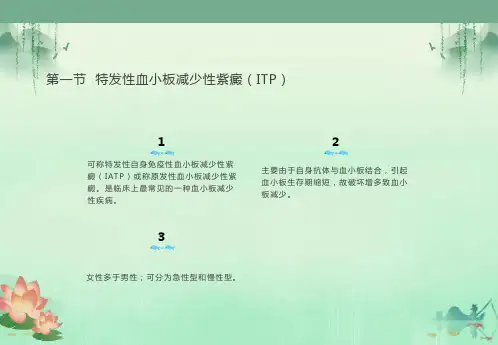

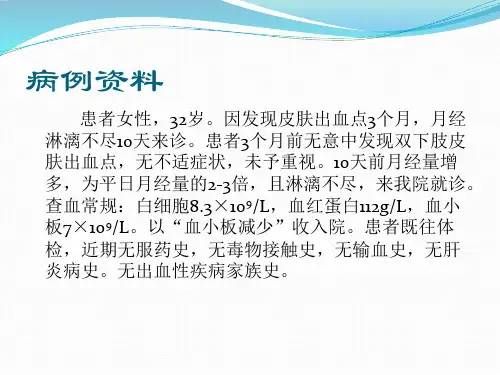
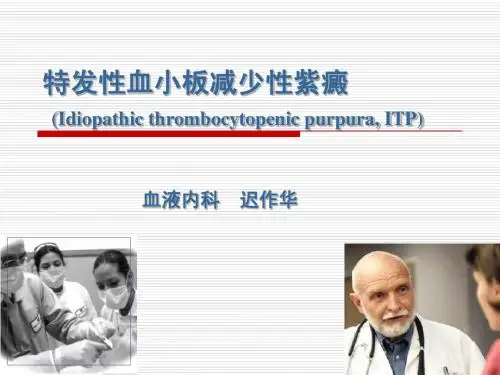

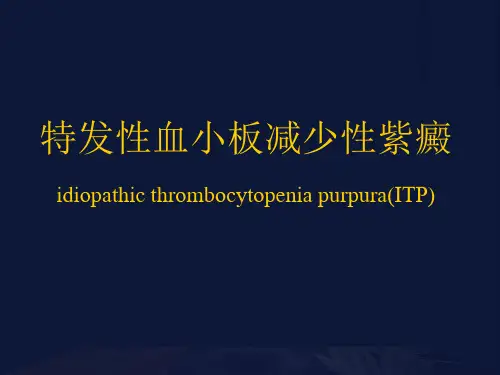
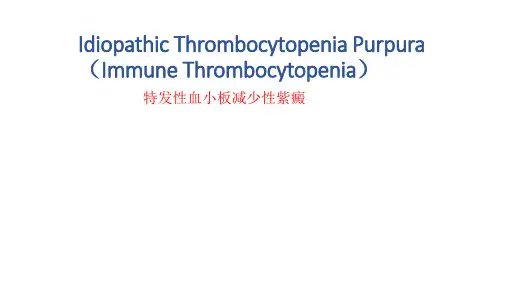
Idiopathic Thrombocytopenia Purpura (Immune Thrombocytopenia)特发性血小板减少性紫癜Outlines•Definition•Epidemiology•Pathogenesis•Signs and symptoms•Laboratory Findings•Diagnosis•TreatmentDefinition•ITP is an autoimmune disease with antibodies detectable against several platelet surface antigens•low platelet count (thrombocytopenia)•It causes a characteristic purpuric rash and an increased tendency to bleedEpidemiologyThe incidence going up with the age get older, F:M = 4:1 in adults, male dominant in children and seniorPathogenesis1. Infection•Bacteria, virus infection commonly•Acute ITP: normally has upper respiratory infection 2-3 weeks before onset•Chronic ITP: Infection could be an induction2. Immunology◆In approximately 60 percent of cases, antibodies against platelets can be detected.Most often these antibodies are against platelet membrane glycoproteins, and are of the immunoglobulin G (IgG) type.◆Normal PLT can be destructed in the patient plasma.◆Immune suppressive drugs is effective to ITP patients.3. CTL induced platelet destructionThe stimulus for auto-antibody production in ITP is probably abnormal T cell activity.Preliminary findings suggest that these T cells can be influenced by drugs that target B cells, such as rituximab.Symptoms•Signs include the spontaneous formation of bruises (purpura) , especially on the extremities, bleeding from the nostrils and/or gums, and menorrhagia (excessive menstrual bleeding), any of which may occur if the platelet count is below 20,000 per μl.•A very low count (<10,000 per μl) may result in the spontaneous formation of hematomas (blood masses) in the mouth or on other mucous membranes.Clinical presentationAcute ITP Chronic ITPAge2-6 yrs Mainly 20-40 yrsGender ND Mainly Female, M:F=1:4 Induction URI 2-3w before onset Mainly infection induced Onset Prompt/with chilly,fever Slow,hidingBleeding Severe,mucus or internal Purpura,mensesorgan hemorrhageHistory2-6 weeks,>80% auto-curable Recurrent attack to yrsLaboratory Findings1.Platelet count2.Bone morrow examination3.PLT antibody: PA IgG4.Evans syndromeLaboratory findingsBlood count (x109/L )platelets <20 mainly 30-80WBC/RBC Normal Normal Lifespan of PLT 1-6 hrs 1-3 days BM morphology Acute ITPChronic ITPHypercellularityNo of megakaryocytes normal orincreased remarkableNormal of E,GAcute ITPChronic ITP(Chronic ITP,Wright stain,x200)(Megalokaryocyte, Gimsa stain, x400)•Serum PA Ig or PA C3PA Ig, G or MPAC3•Evans syndromeITP with AIHADiagnosis1. Clinical presentations of bleeding, no physical signsother than bleedings.2. Low platelet count repeatly3. Despite the destruction of platelets by splenicmacrophages, the spleen is normally not enlarged4. Megakarycytes in BM normal or increased with maturation disorder5.One of the following five:Corticosteriod effectiveSpeletomy effectivePA Ig (+)PA C3 (+)Lifespan of PLT shortened⏹Classification of acute ITP or chronic ITP⏹Exclusion of secondary thrombocytopenia(differential diagnosis)1. Aplastic anemia2. Systemic lupus erythematosus3. Drug induced thrombocytopenia4. Myelodysplastic syndrome5. Acute leukemiaTreatmentThree steps:•Corticosteroids•Splenectomy (removal of the spleen)•Immunosuppressive agentsCyclosporin环孢素Mycophenolate mofetil(MMF) 骁悉Azathioprine 硫唑嘌呤Vincristine 长春新碱Strategy•Corticosteroids•Thrombopoietin receptor agonists•Platelet transfusionExcept in an emergency, it is not recommended and usuallyunsuccessful in producing a long-term platelet count increase.•Rituximaba monoclonal antibody against the B cell surface antigen CD20, maysometimes be an effective alternative to splenectomy.•Introvenous immunoglobulin (IV Ig)Thank you。
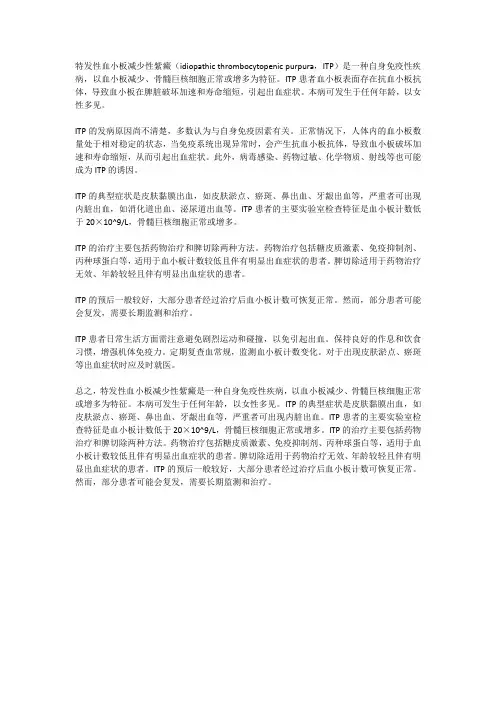
特发性血小板减少性紫癜(idiopathic thrombocytopenic purpura,ITP)是一种自身免疫性疾病,以血小板减少、骨髓巨核细胞正常或增多为特征。
ITP患者血小板表面存在抗血小板抗体,导致血小板在脾脏破坏加速和寿命缩短,引起出血症状。
本病可发生于任何年龄,以女性多见。
ITP的发病原因尚不清楚,多数认为与自身免疫因素有关。
正常情况下,人体内的血小板数量处于相对稳定的状态,当免疫系统出现异常时,会产生抗血小板抗体,导致血小板破坏加速和寿命缩短,从而引起出血症状。
此外,病毒感染、药物过敏、化学物质、射线等也可能成为ITP的诱因。
ITP的典型症状是皮肤黏膜出血,如皮肤淤点、瘀斑、鼻出血、牙龈出血等,严重者可出现内脏出血,如消化道出血、泌尿道出血等。
ITP患者的主要实验室检查特征是血小板计数低于20×10^9/L,骨髓巨核细胞正常或增多。
ITP的治疗主要包括药物治疗和脾切除两种方法。
药物治疗包括糖皮质激素、免疫抑制剂、丙种球蛋白等,适用于血小板计数较低且伴有明显出血症状的患者。
脾切除适用于药物治疗无效、年龄较轻且伴有明显出血症状的患者。
ITP的预后一般较好,大部分患者经过治疗后血小板计数可恢复正常。
然而,部分患者可能会复发,需要长期监测和治疗。
ITP患者日常生活方面需注意避免剧烈运动和碰撞,以免引起出血。
保持良好的作息和饮食习惯,增强机体免疫力。
定期复查血常规,监测血小板计数变化。
对于出现皮肤淤点、瘀斑等出血症状时应及时就医。
总之,特发性血小板减少性紫癜是一种自身免疫性疾病,以血小板减少、骨髓巨核细胞正常或增多为特征。
本病可发生于任何年龄,以女性多见。
ITP的典型症状是皮肤黏膜出血,如皮肤淤点、瘀斑、鼻出血、牙龈出血等,严重者可出现内脏出血。
ITP患者的主要实验室检查特征是血小板计数低于20×10^9/L,骨髓巨核细胞正常或增多。
ITP的治疗主要包括药物治疗和脾切除两种方法。
